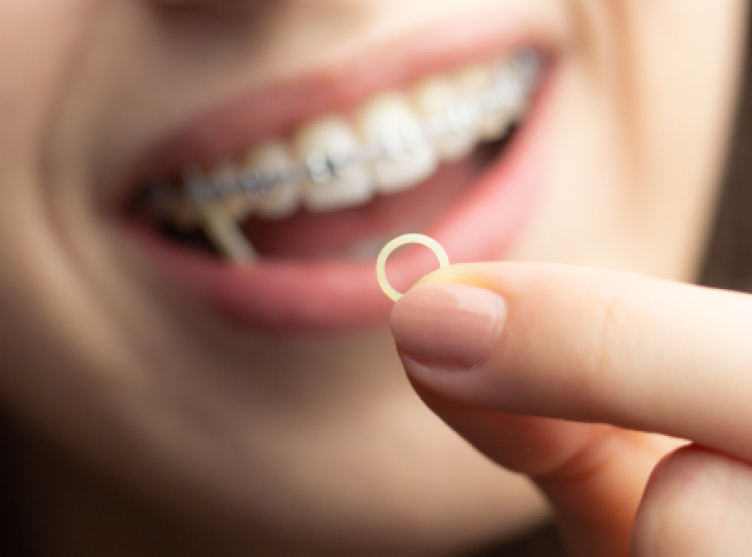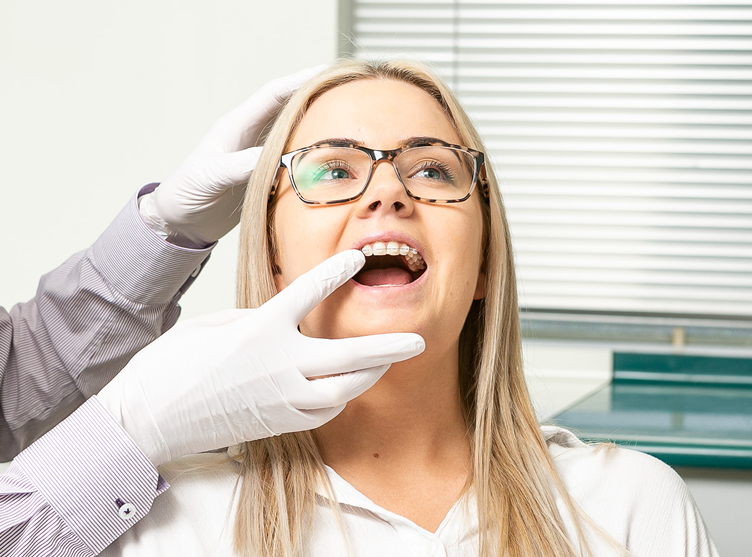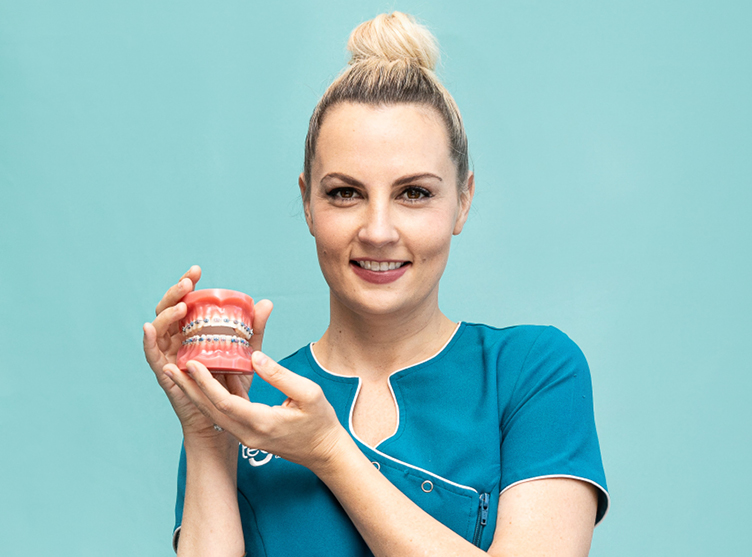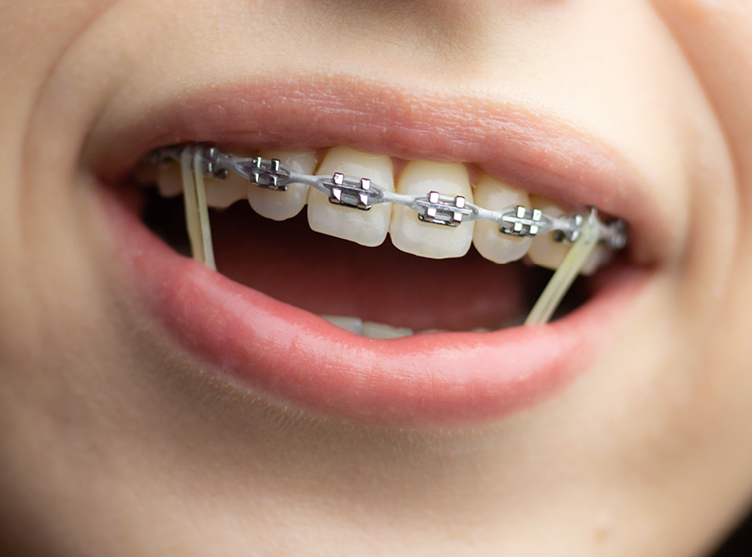
Braces consist of brackets with dental adhesive and flexible wires, gently applying pressure to the teeth to correct misalignment. Some patients undergoing braces treatment need to wear synthetic bands on the upper and lower teeth to assist complex tooth movements or bite adjustments.
Elastics Braces are a type of orthodontic treatment where rubber bands are used to help align teeth and improve the overall bite, as well as facial symmetry. They stretch over tiny hooks on top and bottom braces or clear attachments if you wear clear aligners.
What can Elastics on Braces do?

Rubber or elastic bands on braces are tiny elastics that are commonly used to correct malocclusions—misaligned teeth or improper bites. Elastics help move the teeth into the desired position by applying additional pressure to specific teeth and jaw joints during the bite-fixing phase. It provides steady pressure that helps move the teeth together comfortably and allows them to maintain proper form. Elastics also help correct bite issues by manipulating the jaw joint, which is integral to a successful orthodontic treatment plan.
The rubber band can be used in various ways and is often customised to fit the individual’s needs. Depending on the severity of the malocclusion, patients may need to wear rubber bands for extended periods to achieve the desired result. The rubber band on braces can be adjusted and changed regularly, as required, to ensure progress toward the correct alignment of teeth and jaw.
Types of Elastics Braces
Elastic braces can be divided into three categories: Class I Elastics Braces, Class II Elastics Braces and Class III Elastics braces.
Type 1
Class I elastics braces help closes gaps between teeth. It is usually on the 1st or 2nd molar, hooked to the upper cuspid hook.
Type 2
Class II elastic braces correct overbite by retracting upper teeth and moving lower teeth forward.
Type 3
Class III elastic braces correct underbite by retracting lower teeth and moving upper teeth forward.
How to Use Orthodontic Elastics?

Elastic bands are used to move teeth into proper alignment and improve the overall look of your smile. While they may seem simple enough to use, there are important things you need to know about orthodontic elastics before you begin using them.
Orthodontic elastics are connected between the upper and lower brackets to apply enough pressure for teeth movement. When attaching elastics to your braces, they must be placed properly. You won’t achieve optimal results if you don’t get the proper tension.
It’s important to note that elastics must be changed frequently. It is because the rubber bands stretch over time and lose their tension. Make sure you replace them with new ones when they start feeling loose.
If you need to wear elastics, it’s important that you find ways to make them as comfortable as possible. Invest in elastics that are the right size for your mouth and teeth and wear them properly, with the hooks facing towards your teeth.
When to Start Wearing Braces Rubber Bands?

Your orthodontist may recommend that you start wearing elastics braces and rubber bands at the start of your treatment. It is typically done when a patient has a bite discrepancy or misalignment where the lower and upper teeth do not come together properly when the mouth is closed. Elastics are used to help adjust this misalignment to create a better occlusion or bite.
Elastics are most effective when they are worn consistently, for at least 24 hours daily and should be changed regularly under your orthodontist’s instructions. If the elastic bands cause discomfort or irritation, you can reduce the time they are worn daily, but your orthodontist will likely advise you to wear them for as long as possible. Your orthodontist may also adjust the tension of your elastics during your routine visits, depending on how they affect your teeth and bite.
How long will it take to see results with Orthodontic Elastics?

The time it takes to achieve results when you wear your elastics can range from two months to more than one year, depending on several factors. The most important factor is patient compliance; consistent wear of the elastics is crucial for successful treatment. Additionally, the severity of malocclusion and addressing any other underlying issues can play a role in determining how long treatment with elastics will take. The type of elastic used and the frequency of visits to the orthodontist for tightening and re-attaching can also affect the duration of treatment.
The importance of consistent wear cannot be overstated, as this is key to achieving desired results promptly. Patients need to follow the instructions given by their orthodontist and wear the elastics as prescribed. If you wear elastics for less than the recommended amount of time or forget to change them regularly can slow down progress, so it’s important to stay consistent with use. Patients should also notify their orthodontist about any issues they have when they wear the elastics, such as uncomfortable fit or difficulty maintaining elasticity.
FAQs about Elastics Braces
Can elastics be taken off for eating?
Wear your elastics constantly, even eating. But if it gets in the way, you can take it off. However, it is important to put on new elastics immediately after the meal so that the teeth can return to their proper position. Additionally, it is important to avoid sticky and chewy foods while wearing elastics as they can cause damage or breakage to the elastics.
How often should elastics be changed?
Elastics should be changed daily or as instructed by your orthodontist. It is important to keep the elastics in good condition and replace them when worn out or stretched.
Can Elastics Braces be worn during sports or other activities?
Yes, elastics braces can be worn during activities such as sports. Wearing a mouthguard over the braces is recommended to minimise the risk of damage or injury. Additionally, it is important to check your elastics before engaging in any activity and replace them if they appear stretched or damaged.
Will elastics hurt?
When put on, elastics may cause some initial discomfort, but this should subside. It is because of the pressure on the teeth to ensure they move to the correct position. If the elastics are causing too much pressure resulting in excessive pain or discomfort, it is important to contact your orthodontist for advice.
Are rubber bands the last step to braces?
Rubber bands can often be used as part of the final stages of orthodontic treatment with braces. However, it’s important to note that the use of rubber bands may vary depending on the specific needs of each individual patient. The very last step to braces is to remove them and undergo a retention period in which retainers are worn daily to keep the teeth from shifting back into their original positions.

Conclusion
The result of orthodontic treatment with elastic braces or rubber bands depends on several factors, such as patient compliance, the severity of malocclusion and the type of elastic used. To ensure the best results in a timely fashion, it is important to consistently follow the instructions provided by your orthodontist, change your elastics every day, and avoid sticky or chewy foods. With proper care and adherence to the orthodontic plan, elastics can effectively achieve your perfect smile.
Ready to start your smile journey? Book an appointment with us online.
